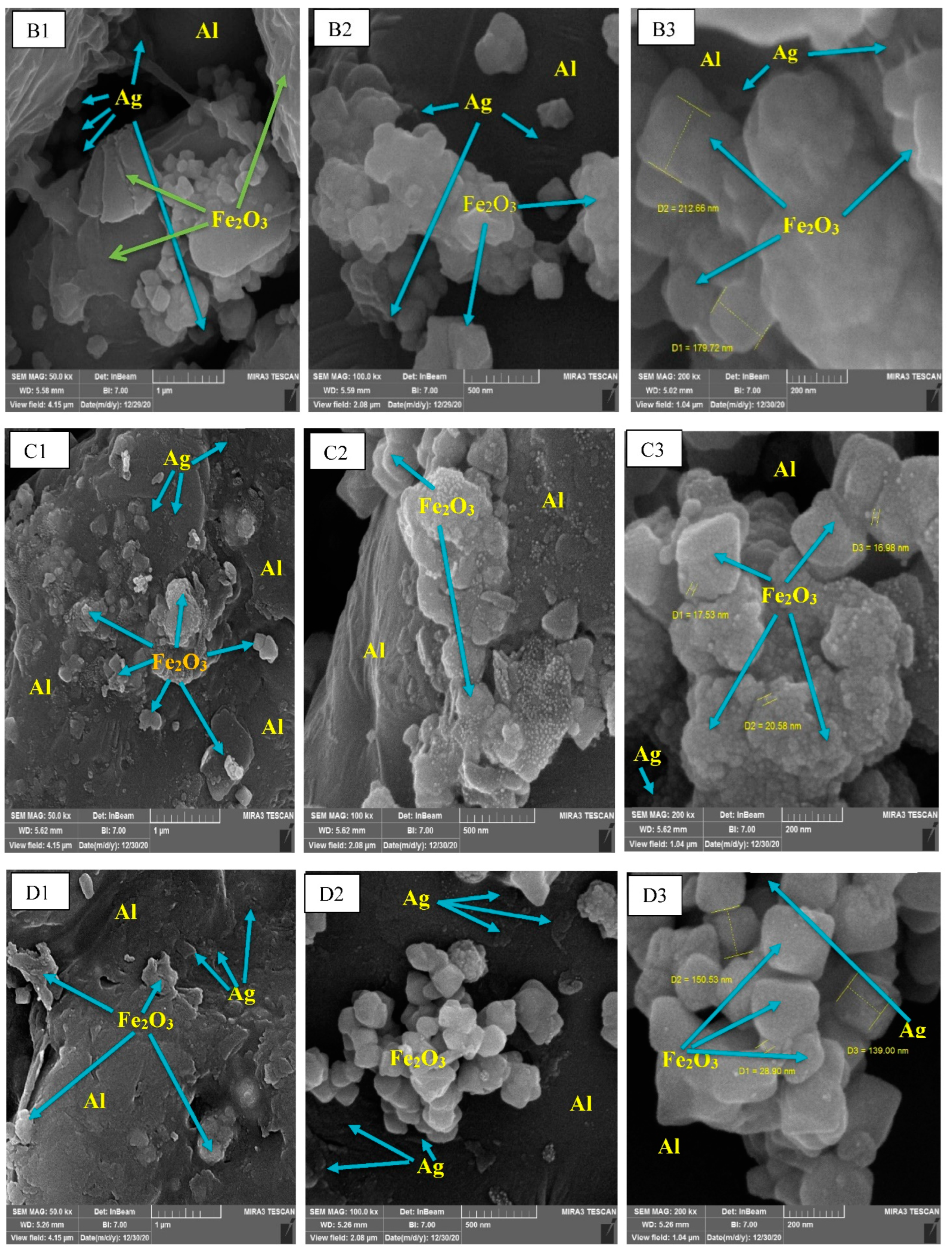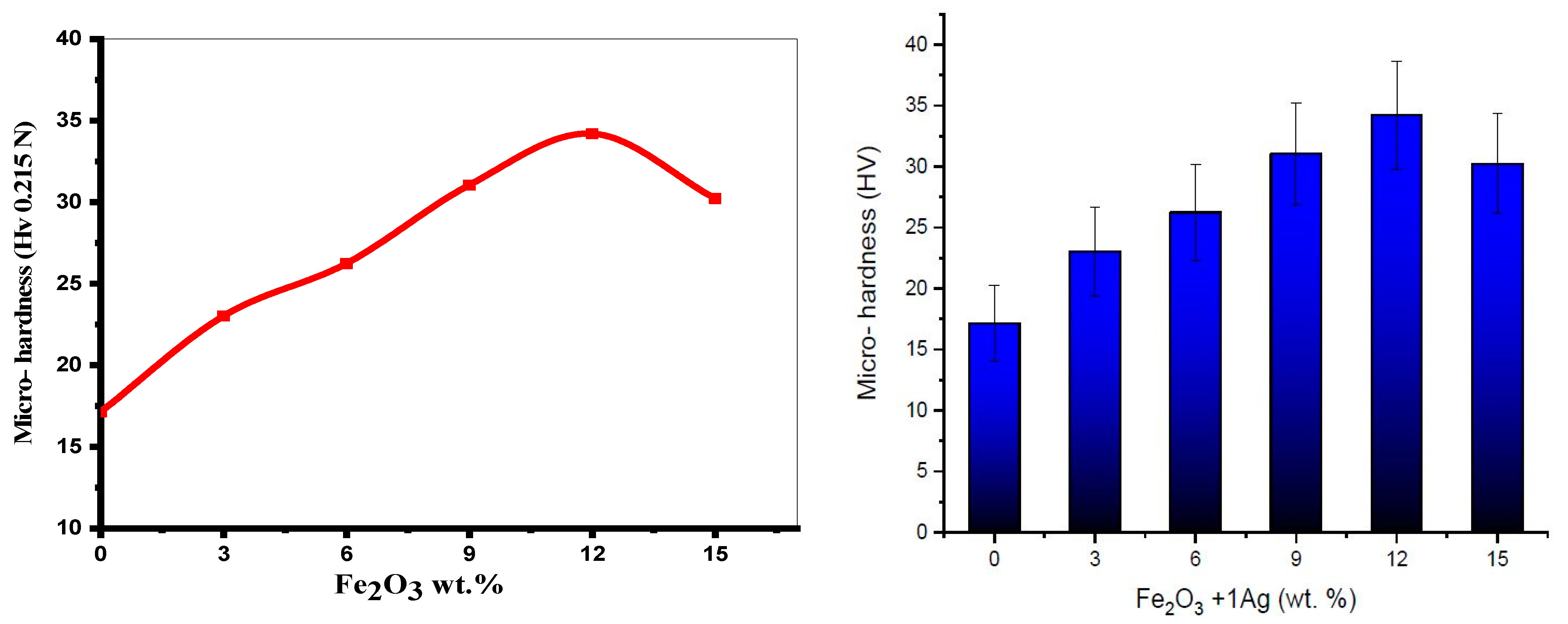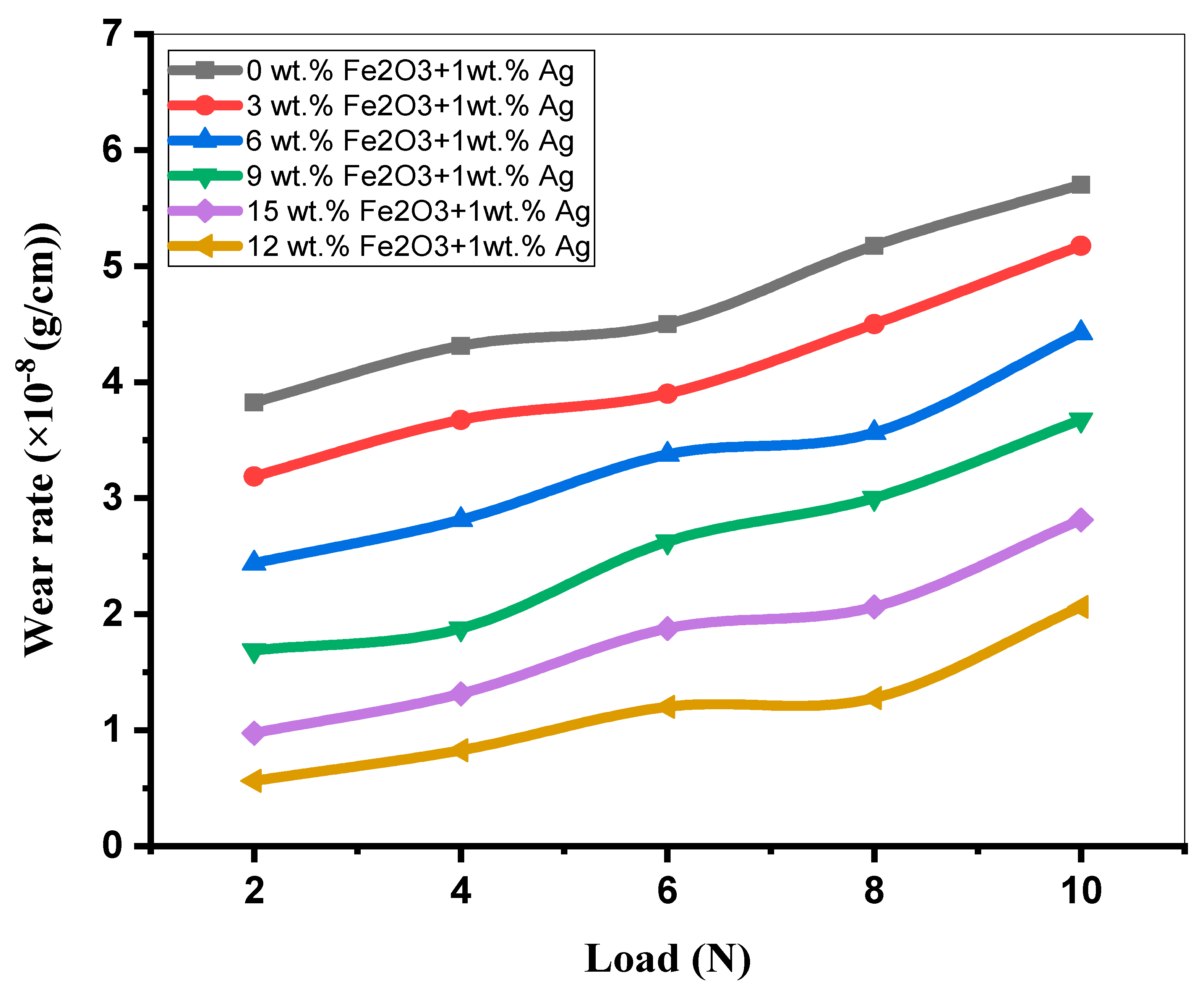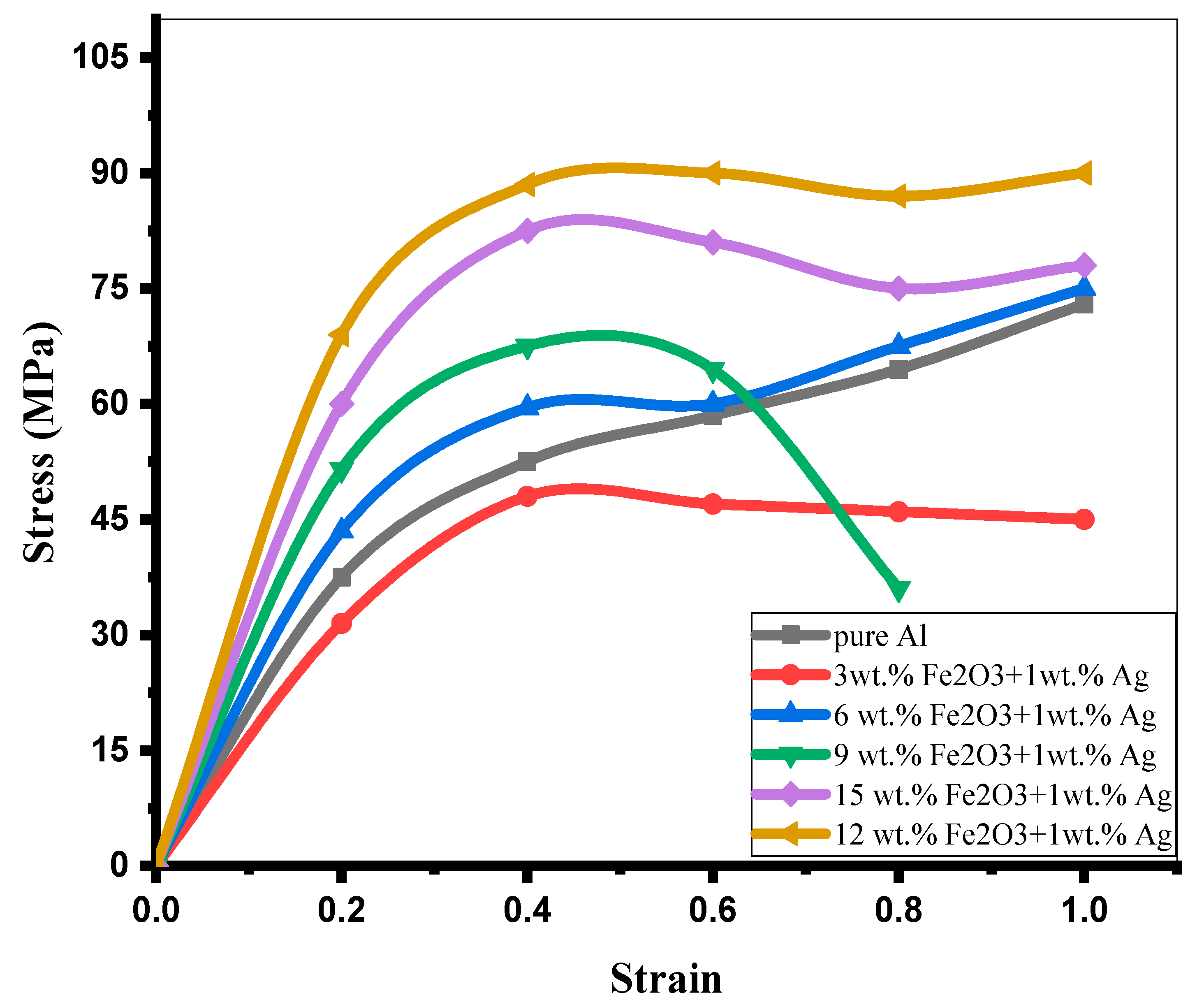Microstructural Analysis and Mechanical Properties of a Hybrid Al/Fe2O3/Ag Nano-Composite
Abstract
:1. Introduction
2. Experimental Section
2.1. Raw Substrates
2.2. Preparing Hybrid Nano-Composites
2.3. Microstructural Examination
2.4. Examination by X-ray Diffraction (XRD)
2.5. Mechanical Properties Definitions
2.5.1. Micro-Hardness Testing
2.5.2. Wear Testing
- Δw: the difference in weight of the samples (g);
- w1, w2: weight of the sample before and after wear testing (g);
- r: rotating disc radius(cm);
- n: revolutions per min (rpm);
- t: sliding time (min).
2.5.3. Compressive Testing
2.6. FTIR Examination
3. Results
3.1. Results of FESEM Examination
3.2. Results of X-ray Diffraction
3.3. Results of Mechanical Testing
3.3.1. Results of Micro-Hardness Testing
3.3.2. Results of Wear Testing
3.3.3. Results of Compressive Testing
3.3.4. Results of FTIR Examination
4. Conclusions
Author Contributions
Funding
Acknowledgments
Conflicts of Interest
References
- Megahed, M.; Attia, M.A.; Abdelhameed, M.; El-Shafei, A.G. Tribological Characterization of Hybrid Metal Matrix Composites Processed by Powder Metallurgy. Acta Met. Sin. 2017, 30, 781–790. [Google Scholar] [CrossRef]
- Bayraktar, E.; Ayari, F.; Tan, M.J.; Tosun-Bayraktar, A.; Katundi, D. Manufacturing of aluminum matrix composites reinforced with iron oxide (Fe3O4) nanoparticles: Microstructural and mechanical properties. Metall. Mater. Trans. B 2014, 45, 352–362. [Google Scholar] [CrossRef]
- Ferreira, L.F.P.; Bayraktar, E.; Miskioglu, I.; Robert, M.H. Recycle of aluminium (A356) for processing of new composites reinforced with magnetic nano iron oxide and molybdenum. In Mechanics of Composite and Multi-functional Materials; Springer: Cham, Switzerland, 2017; Volume 7, pp. 153–161. [Google Scholar]
- Mazahery, A.; Abdizadeh, H.; Baharvandi, H.R. Development of high-performance A356/nano-Al2O3 composites. Mater. Sci. Eng. A 2009, 518, 61–64. [Google Scholar] [CrossRef]
- Mummoorthi, D.; Rajkumar, M.; Kumar, S.G. Advancement and characterization of Al-Mg-Si alloy using reinforcing materials of Fe2O3 and B4C composite produced by stir casting method. J. Mech. Sci. Technol. 2019, 7, 3213–3222. [Google Scholar] [CrossRef]
- Ferreira, L.-M.; Bayraktar, E.; Miskioglu, I.; Robert, M.-H. New magnetic aluminum matrix composites (Al-Zn-Si) reinforced with nano magnetic Fe3O4 for aeronautical applications. Adv. Mater. Process. Technol. 2018, 4, 358–369. [Google Scholar] [CrossRef]
- Alemdağ, Y.; Beder, M. Microstructural, mechanical and tribological properties of Al–7Si–(0–5) Zn alloys. Mater. Des. 2014, 63, 159–167. [Google Scholar] [CrossRef]
- Kurşun, A.; Bayraktar, E.; Robert, M.H. Low cost manufacturing of aluminium-alumina composites. Adv. Mater. Process. Technol. 2015, 1, 515–528. [Google Scholar] [CrossRef]
- Joshua, K.J.; Vijay, S.; Ramkumar, P.; Selvaraj, D.P.; Kim, H.G. Investigation of microstructure and mechanical properties of AA7068 reinforced with MgO prepared using powder metallurgy. In Proceedings of the 2017 First International Conference on Recent Advances in Aerospace Engineering (ICRAAE), Coimbatore, India, 3–4 March 2017; pp. 1–6. [Google Scholar]
- Azhar, A.Z.A.; Mohamad, H.; Ratnam, M.M.; Ahmad, Z.A. The effects of MgO addition on microstructure, mechanical properties and wear performance of zirconia-toughened alumina cutting inserts. J. Alloys Compd. 2010, 497, 316–320. [Google Scholar] [CrossRef]
- Liu, Y.; Zhao, G.J.; Zhang, J.X.; Bai, F.Q.; Zhang, H.X. First-principles investigation on the interfacial interaction and electronic structure of BiVO4/WO3 heterostructure semiconductor material. Appl. Surf. Sci. 2021, 549, 149309. [Google Scholar] [CrossRef]
- Jian, W.; Wang, S.P.; Zhang, H.X.; Bai, F.Q. Disentangling the role of oxygen vacancies on the surface of Fe3O4 and γ-Fe2O3. Inorg. Chem. Front. 2019, 6, 2660–2666. [Google Scholar] [CrossRef]
- Marcu, D.F.; Buzatu, M.; Ghica, V.G.; Petrescu, I.M.; Popescu, G. Expermintal characterztation of aluminum based hybrid composites obtained through powder. In Proceedings of the IOP Conference Series Materials Science and Engineering; IOP Publishing: Tokyo, Japan, 2018; Volume 374. [Google Scholar]
- Erreria, L.F.P.; Bayraktar, I.M.E.; Robert, M.H. Aluminium matrix composite reinforced by nano Fe3O4 doped with TiO2 by thermomechanical process. Mech. Compos. Multi-Funct. Mater. 2017, 7, 251–259. [Google Scholar]
- Ashrafi, N.; Azmah Hanim, M.A.; Sarrf, M.; Sulaiman, S.; Hong, T.S. Microstructural, Tribology and Corrosion Properties of Optimized Fe3O4-SiC Reinforced Aluminum Matrix Hybrid Nano Filler Composite Fabricated through Powder Metallurgy Method. Materials 2020, 13, 4090. [Google Scholar] [CrossRef] [PubMed]
- Tabrizi, A.T.; Aghajani, H.; Saghafian, H.; Laleh, F.F. Correction of Archard equation for wear behavior of modified pure titanium. Tribol. Int. 2021, 155, 106772. [Google Scholar] [CrossRef]
- Nassar, A.E.; Nassar, E.E. Properties of aluminum matrix Nano composites prepared by powder metallurgy processing. J. King Saud Univ.-Eng. Sci. 2017, 29, 295–299. [Google Scholar] [CrossRef] [Green Version]
- Chen, T.; Cao, Z.; Guo, X.; Nie, J.; Xu, J.; Fan, Z.; Du, B. Preparation and characterization of thermosensitive organic–inorganic hybrid microgels with functional Fe3O4 nanoparticles as crosslinker. Polymer 2011, 52, 172–179. [Google Scholar] [CrossRef]
- Zhang, Z.; Chen, D.L. Consideration of Orowan strengthening effect in particulate- reinforced metal matrix nanocomposites: A model for predicting their yield strength. Scr. Mater. 2006, 54, 1321–1326. [Google Scholar] [CrossRef]
- Rajeshkumar, L.R.K. Dry sliding wear behavior of AA2219 reinforced with magnesium oxide and graphite hybrid metal matrix composites. Int. J. Eng. Res. Technol. 2018, 6, 3–8. [Google Scholar]
- Yan, S.; Dai, S.; Zhang, X.; Yang, C.; Hong, Q.; Chen, J.; Lin, Z. Investigating aluminum alloy reinforced by graphene nanoflakes. Mater. Sci. Eng. A 2014, 612, 440–444. [Google Scholar] [CrossRef]
- Madani, H.R. (Cu/Ni)—Al layered double hydroxides@ Fe3O4 as efficient magnetic nanocomposite photocatalyst for visible-light degradation of methylene blue. Res. Chem. Intermed. 2017, 43, 5795–5810. [Google Scholar] [CrossRef]








| Sample No. | Fe2O3 + 1Ag (wt.%) | Micro-Hardness (HV) | STD Error Bars |
|---|---|---|---|
| 1 | 0 | 17.13 | 3.14 |
| 2 | 3 | 23.01 | 3.61 |
| 3 | 6 | 26.23 | 3.95 |
| 4 | 9 | 31.04 | 4.17 |
| 5 | 12 | 34.19 | 4.47 |
| 6 | 15 | 30.22 | 4.10 |
Publisher’s Note: MDPI stays neutral with regard to jurisdictional claims in published maps and institutional affiliations. |
© 2022 by the authors. Licensee MDPI, Basel, Switzerland. This article is an open access article distributed under the terms and conditions of the Creative Commons Attribution (CC BY) license (https://creativecommons.org/licenses/by/4.0/).
Share and Cite
Salman, K.D.; Al-Maliki, W.A.K.; Alobaid, F.; Epple, B. Microstructural Analysis and Mechanical Properties of a Hybrid Al/Fe2O3/Ag Nano-Composite. Appl. Sci. 2022, 12, 4730. https://doi.org/10.3390/app12094730
Salman KD, Al-Maliki WAK, Alobaid F, Epple B. Microstructural Analysis and Mechanical Properties of a Hybrid Al/Fe2O3/Ag Nano-Composite. Applied Sciences. 2022; 12(9):4730. https://doi.org/10.3390/app12094730
Chicago/Turabian StyleSalman, Khansaa Dawood, Wisam Abed Kattea Al-Maliki, Falah Alobaid, and Bernd Epple. 2022. "Microstructural Analysis and Mechanical Properties of a Hybrid Al/Fe2O3/Ag Nano-Composite" Applied Sciences 12, no. 9: 4730. https://doi.org/10.3390/app12094730
APA StyleSalman, K. D., Al-Maliki, W. A. K., Alobaid, F., & Epple, B. (2022). Microstructural Analysis and Mechanical Properties of a Hybrid Al/Fe2O3/Ag Nano-Composite. Applied Sciences, 12(9), 4730. https://doi.org/10.3390/app12094730







